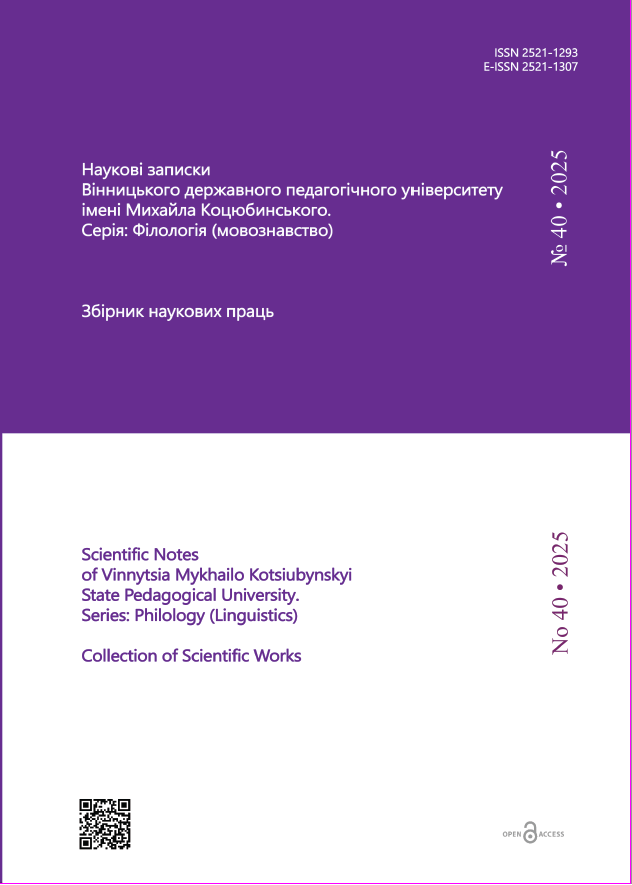Associative field and associative-semantic connections of the lexeme «fake»: comparative analysis
https://doi.org/10.31652/2521-1307-2025-40-04Published 2025-07-07
Keywords
- linguistic discourse, speech aggression, conflict-generating language tactics, communicative linguistics, psycholinguistics, sociolinguistics, media texts, network discourse

This work is licensed under a Creative Commons Attribution 4.0 International License.
How to Cite
Abstract
Media linguistic research, as an innovative direction in modern linguistics, focuses on the study of the language of the media, its influence on mass linguistic consciousness, establishing the laws of media communication, and determining the dominant language strategies of media discourse. The full-scale invasion of an aggressor state and the prolonged hybrid war changed the information space of Ukraine, strengthened the importance of domestic media, and expanded their functions. There are significant transformations in the language culture of the global and domestic media environment, a significant growth in the media terminology system. The lexeme "fake", recognized as the word of the year 2017, topped the list of borrowings in the Ukrainian language, and is actively used in the media and other areas of public life. The purpose of the article is to compare the associative image of the stimulus word "fake" in the linguistic picture of the world of future media workers and the associative-semantic connections of the lexeme "fake" on the material of the Ukrainian Language Corpus. The main research methods chosen were: 1) a free associative experiment to determine the associative image of the lexeme “fake” in the linguistic picture of the world of future journalists; 2) collocational analysis to determine the frequency of use of the word "fake" with semantically related lexemes and identify contextual connotations; 3) thematic modeling of a random sample of 400 texts from the Ukrainian language corpus with the word “fake” to determine the associative and semantic connections of the studied word. Results. The core of the associative field of the word-stimulus is represented verbally by simple paradigmatic reactions: lie, untruth, false information; the perinuclear zone of the field is formed by eight associates: slander, unreliability, disinformation, scammers, media, social networks, evil, deception. The number of variable associates of the lexeme "fake" (93 reactions, 43.9%) is significant, which indicates the prospect of changes in the core and perinuclear zone of the associative field, hence, transformations and shifts in the semantic scope of the corresponding word. As a result of the search using the “collocation” option, a group of lexemes semantically related to the word “fake” was identified: spread, Russian, news, name, propaganda, information, refute, next, Ukraine, Russia, media, elections. The results of thematic modeling significantly complement the associative image of the lexeme "fake" and represent typical contexts for identifying associative-semantic connections of this word. The core and the right associative field clearly correlate with the four simulated themes. It has been established that in thematic modeling, fakes are mainly associated with the media, and in associative modeling, with social networks. Collocational analysis and thematic modeling of the lexeme "fake" demonstrate more frequent associative and semantic connections of this word with nomenclature denoting the realities of war. Originality. The article describes the semantic scope of the lexeme "fake" taking into account the system of associative connections of the word based on the materials of a free associative experiment, collocational analysis, and thematic modeling. Conclusion. To study the associative semantics of a word, it is necessary to expand the empirical base and supplement the methodological tools. Our research combines materials from a free associative experiment and the Ukrainian Language Corpus to identify associative-semantic connections of the lexeme "fake". We see the prospect of further research in continuing and deepening the analysis of the associative semantics of media discourse, as well as organizing associative experiments in the future to track the dynamics of associative images.
Downloads
References
- Бабич, М. Є., Слива, Т. В. (2024) Асоціативно-семантичні зв'язки лексеми війна (на матеріалі корпусу української мови). Закарпатські філологічні студії, вип. 37, с. 9-13. https://dspace.uzhnu.edu.ua/jspui/handle/lib/72351 (07.02.2025).
- ВТСУМ (2001) – Великий тлумачний словник сучасної української мови / укл. та гол. ред. В'ячеслав Бусел. Київ ; Ірпінь : Перун. https://slovnyk.me/dict/vts/%D0%B0%D1%81%D0%BE%D1%86%D1%96%D0%B0%D1%86%D1%96%D1%8F (07.02.2025).
- Генеральний регіонально анотований корпус української мови (ГРАК) https: //uacorpus.org/ (09.02.2025).
- Голованова, Н. В. (2017). Медіапростір як важливий чинник побудови інформаційного суспільства. Актуальні проблеми державного управління, № 1 (51), с. 27-34.
- Денисевич, О. В. (2018). Асоціативне поле слова-стимулу «газета» в мовній картині світу українців. Вісник Книжкової палати, № 8, с. 29-31.
- Ділай, І.П., Ділай, М. П. (2022). Роль частотності у лінгвістичних дослідженнях. Закарпатські філологічні студії, вип. 21, т. 1, с. 146-151.
- Караванський, С. (2000). Практичний словник синонімів української мови. Київ : «Українська книга», 480 с.
- Кухар, Н. І., Гандзюк, В. О. (2024) Асоціативні образи медіа і журналіста в мовній картині світу майбутніх педагогів. Наукові записки Вінницького державного педагогічного університету імені Михайла Коцюбинського. Серія: Філологія (мовознавство): збірник наукових праць, вип. 38, с. 15-22. https://doi.org/10.31652/2521-1307-2024-38-02 DOI: https://doi.org/10.31652/2521-1307-2024-38-02
- Мудра, І. (2016). Поняття «фейк» та його види у ЗМІ. Теле- та радіожурналістика, вип. 15, с. 184-188.
- Панчук, Д. М. Фейк. Велика українська енциклопедія. https://vue.gov.ua/Фейк (07.02.2025).
- Рибачок, С. М. (2020). Лексичні засоби впливу мовної одиниці «фейк». Наукові записки Національного університету «Острозька академія»: серія «Філологія», вип. 9(77), с. 121-124. DOI: https://doi.org/10.25264/2519-2558-2020-9(77)-121-124
- Селезньова, О. М. (2022). Термін «медіапростір»: теоретичний підхід. Науковий вісник Ужгородського Національного Університету. Серія ПРАВО, вип. 70, с. 359-363.
- СУМ 1970 – Словник української мови: в 11 тт. / АН УРСР. Інститут мовознавства; за ред. І. К. Білодіда. Київ : Наукова думка, т. 1.
- Шевченко, Л. І., Дергач, Д. В., Сизонов, Д. Ю. (2014). Медіалінгвістика : словник термінів і понять / за ред. Л. І. Шевченко. Вид. 2-ге, випр. і доп. Київ, 380 с.
- Яроцька, Г. (2019). Лінгвоаксіологічні аспекти рейтингового списку слів 2018 року. Вісник Одеського національного університету. Філологія, т. 24, вип. 1(19), с. 118-124. http://philolvisnyk.onu.edu.ua/article/view/235627 (06.02.2025).
- CET – Collins English Thesaurus. https://www.collinsdictionary.com/dictionary/english/fake-news. (01.02.2025).





